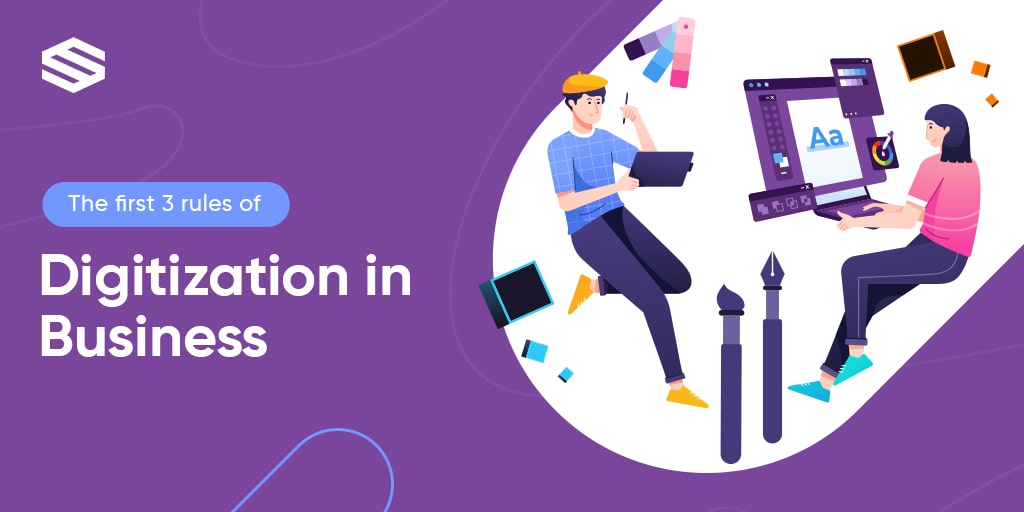The first 3 rules of Digitization in Business

Digitization is perhaps one of the hottest buzzwords today. And with the COVID-19 mutations happening all over the world, the demand for digital-first platforms has accelerated. However, with the apparent need and prioritization of digital tools and resources for businesses, many companies are still lagging.
Digitization wasn’t a key priority for most businesses in the past. Still, with the pressing necessity caused by the pandemic, it should be at the top of every business leader’s mind. Digitization, when implemented successfully, can minimize business risks and help better compete with others in your industry. Taking the necessary steps to transcend your business into digitization can help you weather crises – such as a pandemic.
So how can one company digitally transform its business successfully? Well, there are no hard-fast rules into it. But, having a booster upper can help you start in the right direction. Here are the first three rules of digitization in business.
Rule #1: Digitization requires establishing internal protocols.
As with any other part of your business, digitization requires sound and thorough planning. It’s one thing to go fully digital. It’s also another thing to fully understand how the transformation can affect your employees and customers.
In any digitization effort, learning curves and constant commitment to resources are a requirement. And skipping on planning and preparation could overwhelm your initiative and effort to digitize your business processes.
Alyce L. Scott, San Jose State University professor, explains that digital projects hinge on expensive technology and thorough and practical planning. Determine your goals first, the appropriate technology will follow, and only then can you meet a project’s objectives. Going the other way around can be disastrous for your business.
Rule #2: Digitization requires tapping the power of the cloud.
With the progress of technology, most of us have used a form of cloud technology. Whether streaming your favorite movies and music online or using cloud-based services in saving files online – you’re tapping into the power of cloud technology.
This technology can also do many wonders for your business. Ajay Serohi, supply chain and logistics expert and staff product manager at Tesla, stated that cloud technology could enable business leaders and their employees to obtain and update vital information from anywhere in the world – even in the comforts of your own home.
Cloud apps and systems can help your business manage most of your business, from payroll to quotes and invoices to the supply chain, to improve your business’s overall efficiency and operational power. Customer relationship management cloud-based systems can be beneficial for your business, too, since these systems offer a more centralized location of crucial information for your marketing and sales teams. Your team can update data in real-time from various sources, too. Cloud-based platforms give you accurate information for better-informed decision-making and better manage performance.
The main benefit of cloud-based technologies is that they’re scalable and customizable to your business needs. This benefit negates the need to migrate from one technology to another after expanding your borders as a business.
Rule #3: Digitization requires identifying and leveraging digital partnerships.
When you utilize cloud-based systems, this could also mean that you’re using third-party systems to help facilitate your digitization efforts.
What are third-party apps?
Third-party apps are software applications made by developers other than the manufacturer of a cloud-based system or its operating system. These apps can vary from payment gateways (Paypal or Skrill) to chatbots to any applications available in the market. You can integrate these apps into a system of your choosing (like a CRM) and use them fully without having to pay more for subscription fees.
As you go through your planning efforts, you should give specific attention to tasks or processes that benefit the most from automation. Of course, several automation tools and SaaS platforms in the market essentially perform the same functions. The main point is maximizing your budget.
To make the most of your budget, you must meticulously assess the various tools that could automate desired tasks. Don’t just look at the initial pricing or its popularity. Remember, not all tools are made equal. Consider if a particular system manufacturer offers the ability to scale with your company’s growth. This capability will likely be a better option to handle your needs in the long run. Checking third-party reviews are always a must, too!
Key Takeaway
Digitization is a long process, and the pace of your journey will never be the same as others. To get to where you’re heading, you need rules and directions.
In your search for a system to kick off your efforts, Saphyte can help you answer some of the frequently asked questions by companies attempting to start their digitization efforts. You can book a call with our digitization experts, help you through your starting point, and walk with you until you can run.
Call us today or book a free demo. Kick off your digitization journey today and never lag behind your competitors.
Curious how digital ecosystems can help improve your business?
Check out how digital ecosystems can boost your company performance by getting started here.
Book a Demo